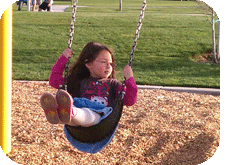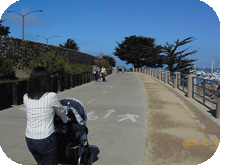
This mailer has been provided as an avenue of dispersing information related to landscape architecture in hopes of fostering greater understanding and collaboration between professions. Topics address issues that affect the built environment within which we live.
Three reasons why parks and recreation budgets should not be cut when money is tight ....
"The time has come for Americans to rededicate themselves to the vision of parks for all the nations people", Will Rogers, Trust for Public Land
As the country continues to struggle through economic hardship, a trend of drastically reducing parks and recreation department budgets (or dissolving parks departments all together) has begun to emerge. Keeping in mind the fact that budgets need to be cut somewhere, this month's article discusses how preserving parks and recreation funds can actually reduce the need to allocate funding to other public departments such as public safety and health departments. Though there are many reasons to protect public parks and recreational opportunities, the following are three compelling reasons: crime rate reduction, health benefits, and economic benefits.
 Crime Rate Reduction - Studies have shown that well-maintained parks and active recreational programs reduce crime in urban areas. Unfortunately the opposite is also true, un-maintained parks (or no park space) and lack of recreational programs leads to higher crime rates. A few of the many positive influences parks can have on crime are summarized below.
Crime Rate Reduction - Studies have shown that well-maintained parks and active recreational programs reduce crime in urban areas. Unfortunately the opposite is also true, un-maintained parks (or no park space) and lack of recreational programs leads to higher crime rates. A few of the many positive influences parks can have on crime are summarized below.
Recreational facilities provide wholesome activities for at-risk youth, keeping them off the streets and in proper social atmospheres. Many cities are reporting significant decreases in crime due to youth programs such as midnight basketball. Fort Meyer's, Kansas City and Fort Worth all report declines in juvenile arrests, following similar program implementation, of 28%, 25% and 28% respectively.1 The City of Edinburgh Police Department also reports a drop in juvenile crime after a skate park was constructed in their community.2
Greener cities result in fewer total crimes. Research has shown that there is a strong correlation between levels of vegetation and number of crimes in the immediate area. One study by the University of Illinois reports a 7-8% reduction in crime attributed directly to the presence of nearby vegetation.4 This finding is significant as it is contrary to the common undocumented belief that vegetation promotes crime.
Physical activity, and exposure to green open space, helps relieve mental fatigue resulting in reduced aggression. Inattentiveness, irritability and lack of impulse control are all symptoms of mental fatigue which is correlated with aggression. Aggression, violence and fatigue are all positively impacted by exercise and park like atmospheres which foster mental rejuvenation and help minimize fatigue. Research confirms the statement that "park-like" atmospheres have been shown to increase neighborhood safety.1
Socially connected neighborhoods are stronger and safer. Green spaces in neighborhoods tend to encourage formal and informal social interaction. This interaction is crucial in developing a web of neighborhood relationships. This web of relationships is the core of a neighborhood's strength. It creates un-isolated, supported and empowered people. Research has shown that those living in neighborhoods near green spaces with a strong social web, express higher levels of comfort and safety.1An additional study showed that combined social control, cohesion and trust are a "robust predictor" of reduced levels of violence.5 Closely related to this idea is the reality that parks and open spaces need to be well maintained in order to successfully assist in reducing crime. The National Institute of Justice finds that disorder is directly related to crime levels. This same study also finds that policies which attempt to reduce crime (due to disorder) by means of strict law enforcement tactics alone are misguided! A suggested long-term approach for lowering crime should focus on strengthening community's local ties, relationships and awareness.6 Parks and open spaces are one of the many methods of implementing this type of strategy.
 Health Benefits - Parks are also beneficial to the overall community health by providing open spaces and facilities for recreation and exercise. People who live near these facilities tend to be more active, resulting in healthier communities. A study in the Netherlands found that people in green environments report fewer health problems, have better mental health and think they are healthier. The study also suggests that an estimated five years can be added to an individual's life by increasing nearby greenspace by 10%.7
Health Benefits - Parks are also beneficial to the overall community health by providing open spaces and facilities for recreation and exercise. People who live near these facilities tend to be more active, resulting in healthier communities. A study in the Netherlands found that people in green environments report fewer health problems, have better mental health and think they are healthier. The study also suggests that an estimated five years can be added to an individual's life by increasing nearby greenspace by 10%.7
The Center for Disease Control and several studies show that 35.6% more citizens in communities providing enhanced access to places for physical activity exercise three days a week or more. When public outreach is performed in addition to improved access, this percentage can increase to 48.4%.7 This increase in activity leads to reductions in body fat, weight loss, flexibility and perceived energy! The benefits of parks and open space related to health are not limited to this however, psychological health benefits are also strongly documented. Features of the landscape have been integrated into many mental health treatments, community programs, hospital campuses, geriatric programs, prison curriculums and programs for people with disabilities.
A project by the Trust for Public Land, based on many studies, approached this issue quantifiably and determined an average health cost differential between those who actively recreate and those who do not. The average annual potential savings per individual under 65 years of age is $250. That number increases to $500 dollars for individuals over 65 years old.7 It is apparent that monetary savings related to health care costs in our communities can be realized by providing facilities for public recreation.
 Economic Benefits - The effects of parks and opens spaces on local economies can be wide reaching. Two areas of impact however, are most important: property values and tourism.
Economic Benefits - The effects of parks and opens spaces on local economies can be wide reaching. Two areas of impact however, are most important: property values and tourism.
Extensive research has been completed throughout the country with regard to the effects of parks on real-estate prices. The conclusions are unmistakable. People are willing to pay more for commercial and residential real-estate near well maintained parks, up to 15% more! This leads to significant increases in property taxes. The opposite scenario, however, is also true. Ill maintained parks can lead to a drop in value of up to 5%.3 The real-life application of this study is, if communities do not have parks, contemplate building them to increase property tax revenue, and if parks already exist, allocate money to maintain them and avoid significant losses in property taxes.
Revenue can also be generated in well-maintained parks by hosting community events, sporting events, art and food festivals, music events and theatrical / film events. These events act as catalysts for positive economic impacts by filling hotels and restaurants and by increasing spending within the community. Out of town visitors or tourists are also a very valid reason to avoid reducing funding sources for large parks, revenue generating parks and/or regional parks. Facilities that draw in significant crowds need to be embraced, improved and maintained at levels which increase visitation and result in increased tax revenue. Each park system should be assessed carefully to determine if budget reductions will inhibit the ability for the parks system to generate capital for use within the park system and its ability to generate tax revenue.
Though commonly viewed as expendable, parks are a vital component of the community and minimize long term avoidable costs associated with public safety, health and the local economy. There are many other benefits of parks not mentioned in this article. If you are interested in additional information and research into this topic please contact O'Dell Engineering.
Prior Issues of Interest
- Artificial Landscape Water Cycles
- Dog Park Basics
- Playground Safety: What's the Big Deal?
- Artificial Turf: A Pros & Cons Review
- The Vestibular and Proprioceptive Sensory Systems
The next time you need a Landscape Architect on your project, consider O'Dell Engineering's Landscape Architecture Department.
Services include:
- Park and Playground Design
- Recreational Facility Design
- Site Planning
- Streetscape Design
- Urban Design
- Commercial Design
- Model / Production Homes
- 3-D Visualizations
- Graphic Design
- Arboriculture Consulting
- Playground Inspection
References:
1-American Planning Association- How cities use parks to create safer neighborhoods. APA. Chicago. 2003.
2-Cummings, Jason. New skatepark sees drop in youth crime. Edinburgh Evening News. Dec. 17, 2003. http://news.scotsman.com/edinburgh.cfm?id=1383262003
3-Harnik, Peter and Ben Welle. Measuring the economic value of a city park system. The Trust for Public Land. 2009
4-Kuo, E. Frances and William C. Sullivan.Environment and Crime in the Inner City: Does vegetation reduce crime?. Environment and Behavior. Sage Publications. 2001. Vol. 33 No.3, May 2001 343-367.
5-Sampson, Robert, J. Stephen W. Raudenbush and Felton Earls. Neighborhoods and violent crime: A multilevel study of collective efficacy. Science. 1997. Vol. 227. August 918-924.
6-Samuels, Julie E. Disorder in urban neighborhoods: Does it lead to crime. National Institute of Justice. February 2001.
7-Sherer, Paul M. The Benefits of Parks: Why America needs more city parks and open space. TheTrust for Public Land. San Francisco, 2006.
Author: Chad Kennedy, Landscape Architect
This informational article provided by O'Dell Engineering - 1165 Scenic Drive, Suite A, Modesto CA 95350